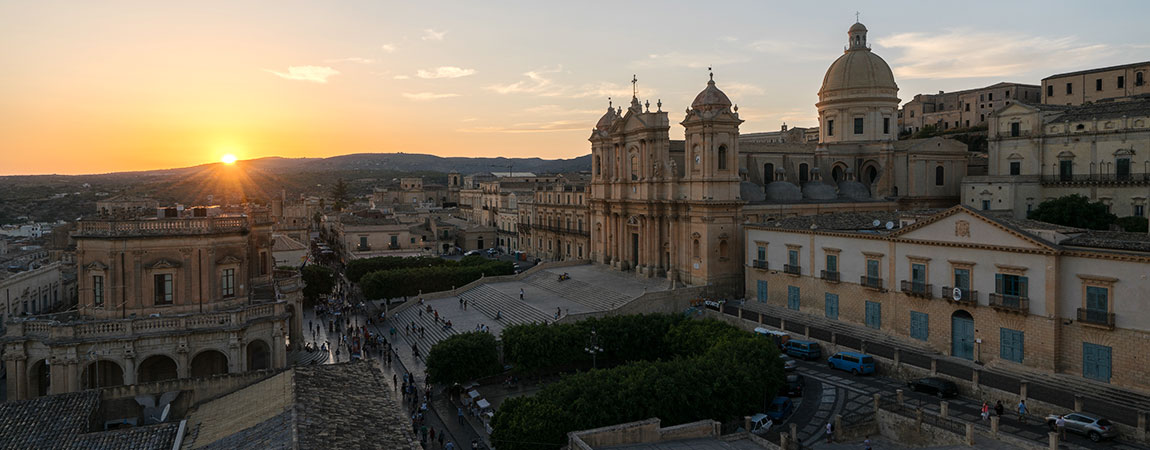
When we think of Noto, in south-eastern Sicily, we think of Vincenzo Sinatra and the Baroque city, the Cathedral of San Nicolò and the majestic Church of San Domenico, but too often we forget that there is also another Noto, the ancient Noto, the one who lived before the earthquake that undermined the valley in 1693.
This year became the watershed in the history of the city, handing the ancient part of Noto forever to the "before". This ancient part, however, although destroyed, has not been lost and today for visitors arriving in Noto it is possible to retrace the streets of the centre, admiring what remains of the ancient glories of the city.
The history of Noto
The area of Known ancient, was already inhabited in prehistory and at the time of the Romans (in the fifth century AD) there was the municipium, which later became Civitas in the time of Ferdinand the Catholic.
There is no shortage of examples of medieval architecture in this ancient part of the city, such as the Hermitage of Santa Maria della Provvidenza, which dates back to 1091, although it was later remodeled in the XNUMXth century.
As early as the 1693th century, the center was an important military outpost, which gradually increased its influence over the following two centuries, also gaining a place in the cultural world of the time and achieving important economic goals. To interrupt this positive trend, the earthquake of January XNUMX arrived, which upset the whole Val di Noto and the center of Known ancient. The oldest part of Noto, at the Mount Alveria, is located about 8 km from the Known modern.
What to see in ancient Noto
Ideally dividing the story of Known ancient, we can indicate the testimonies of each period in the remains of the city.
Of the prehistoric age are witnesses i archaeological finds find yourself on Mount Alveria, while evident traces of the Roman period remain in the mosaics of the Villa del Tellaro; the Crypt of San Lorenzo Vecchio, the Trigona di Cittadella and the Basilica of Eloro date back instead in the Byzantine era, while the Arabs dominated the city in the XNUMXth century, colonizing the countryside.
Il Royal Castle of Noto and Monastery of Santa Maria dell'Arco they were among the first constructions built by the Normans in the XNUMXth century and testify one of the political life of the city, which passed from the Aragonese to the Angevins in the XNUMXth century and the other the spiritual life of Noto, with one of the first Christian buildings in the city. There Main Tower of the Castle, however, symbolizes the rediscovered power of the Aragonese in ancient Noto.
During the XNUMXth century, the cultural vein of the center exploded, giving birth to characters of the caliber of Giovanni Aurispa, merchant and poet or Matteo Carnalivari, architect.
The story of Known ancient, set off towards a future of cultural, artistic and economic successes, was tragically interrupted at 21:00 on 9 January 1693.
What to see in Noto
After the earthquake, the Duke of Camastra immediately received the task of rebuilding the city and decided to move the center about 8 km downstream, on the slope of the Mount Meti. Mathematicians and engineers, architects and stonemasons worked together to completely rebuild the city of Noto: Carlos de Grunenbergh, Giovanni Battista Landolina, Giuseppe Formenti are some of the names to which the memory of Noto remains linked.
In the eighteenth-century "new historic center" it is now possible to admire buildings such as the Basilica of San Nicolò, built in 1776 and became UNESCO World Heritage Site, Church of the Most Holy Crucifix with its unfinished facade and the magnificent Church of San Carlo al Corso; there are dozens of sacred buildings Known new, in which we advise you to enter, to admire the splendor of the reconstruction.
The palaces of civil architecture are no less, such as Palace Ducetius, designed by Vincenzo Sinatra and seat of the Town Hall, the Municipal Theater Tina di Lorenzo, built in the second half of the nineteenth century and the Port Royal built in 1838, in honor of Ferdinand II of Bourbon.
What to do in Noto and surroundings
Flavors of Noto
If the beauties of art satiate the spirit of visitors, in Noto even the most demanding palates can be satisfied, with a simple stop at the restaurant: from the menu, choose busiate with pork ragout or fish couscous, try fried oranges or olives and don't give up on dessert, which can be the classic Sicilian cannoli, or a delicious tray of almond paste biscuits.
How to reach Noto and ancient Noto
Noto, in the province of Syracuse, can be reached in the car, from the A18 Messina-Catania, taking the exit for Noto, or on the train, getting off at Syracuse station.
From Noto, you can reach ancient Noto by car, via the SP 64 and the SS287.
© Image by Gianluca Pirro, CC BY-SA 4.0, via Wikimedia Commons









